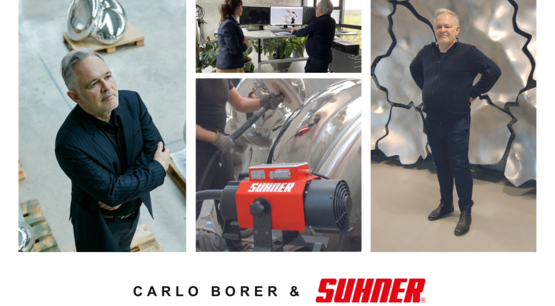We at SUHNER are proud to give you an insight into a remarkable creative collaboration today. In an exclusive interview, you can find out more about how our company and renowned artist Carlo Borer are working together to create ground-breaking artworks that blur the boundaries between technology and art. Carlo Borer has made a name for himself by pushing the boundaries of conventional art forms. His stainless steel works are not only aesthetically pleasing, but also technically sophisticated. In our interview, the artist explains how he uses SUHNER's precise and powerful machines to achieve perfect results for his artworks.
Interview SUHNER & Carlo Bohrer in Oberrbipp in the canton of Bern (studio/house of the artist)
Thank you, Mr Borer, for taking the time to give us an interview in which we would like to focus on your techniques. You have just returned from Düsseldorf, where you opened an exhibition.
The theme "Hurricanes, pulsars and other curious curves" shows various objects that have been 3D moulded, i.e. hammered, or laser-cut from sheet metal, rounded and welded.
We imagine that their stainless steel objects in particular require intensive processing. The result must be perfect!
From the idea in the CAD programme - to the three-dimensional object and yet your objects are still traditionally, i.e. handcrafted and implemented.
SUHNER: How did you come up with the idea of processing your objects with a flexible shaft machine, the ROTOmax 4.2 TWIN from SUHNER?
C.Borer: Quite simple: You take the tool that fits best, with which you can achieve the best performance. The reason why I work with flexible shafts is certainly that I can bring incredible force to the front of the tool. We have polishing wheels with a diameter of 30 to 35 cm. That requires incredible force. I notice this with other machines, some of which can no longer manage this because they can't apply this force to the tool.
SUHNER: What influence does this technique have on your artistic work and your creative processes?
C.Borer: Actually, I don't want the technology to have any influence on my work. The technique should enable me to realise my ideas perfectly, the way I imagine them. So I choose the technology that enables me to realise my ideas.
SUHNER: What challenges have you experienced when using these machines in your art?
C.Borer: Generally speaking, you are always looking for machines that solve a problem, that provide an application, and I have always had very good experiences with SUHNER products because the machine can be used universally and can therefore often solve many problems. Conclusion: because the ROTOmax 4.2 TWIN simply has the power to fulfil these very robust requirements.
SUHNER: How long does it usually take to process an object using this technique?
C.Borer: It's difficult to say, of course, because it depends on the size of the object, the surface you want to work on and also the quality of the materials; I sometimes marvel myself at how differently stainless steel behaves - seemingly the same material and yet suddenly different material reactions. With reference to SUHNER, I have the option of using the flexible shaft machine to clamp large polishing cloths and thus of course process much larger surfaces much more effectively. I save a lot of time here because I can work so "big". With the five speeds that can be programmed on the ROTOmax 4.2 TWIN, I also immediately have the right speed.
SUHNER: What role do the movement and dynamics of the flexible shafts play in your works of art?
C.Borer:When working with a flexible shaft, and I always have the most robust one, "the monster", and with this flexible shaft you are of course not quite as free as you would be if you had a pneumatic tool. But with the ROTOmax 4.2 TWIN, I have this tremendous force that I can use, which no other tool in my experience would ever have brought to the metal. In this respect, you are a little less flexible, despite the flexible shaft, but you simply have this incredible power that enables a massive use of energy.
SUHNER: Have you developed special techniques to achieve the desired effects with the machines?
C.Borer: We have searched intensively for the right way. What works for stainless steel doesn't necessarily work for plastic or brass or any other material. Every material reacts differently. We are particularly familiar with stainless steel and have tried out and perfected our approach over a long period of time.
SUHNER: How has your art developed over time through the use of flexible shaft machines?
C.Borer: Yes, it would be crazy for me as an artist to feel the influence of technology on my work so strongly. The technology has to produce what I want. The technology has to solve my problems. But of course, thanks to the SUHNER technology that you provide me with, I have been able to raise the level of perfection even further and develop a consistent quality.
SUHNER: How do you see the future of your artistic work with this technology and what new possibilities could arise from it?
C.Borer: Of course I would like to have a solution for the future. It's still a lot of labour-intensive manual work. I would really like to use a robot with a SUHNER shaft or similar mounted on it so that I can easily programme individual objects/small series and use the power of the robot arm.
SUHNER: Thank you Mr Borer for the exciting interview and the insight into your artistic work.
The SUHNER interview was conducted by: Mariana Maglione, Daniela Andova and Britta Mehlin
More information at: www.carloborer.ch and www.suhner.com


Follow us on